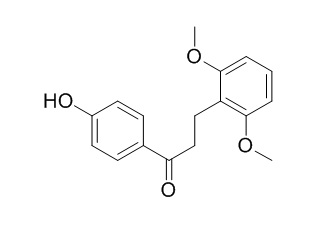Cochinchinenin A
The combination of Cochinchinenin A, cochinchinenin B, and loureirin B is the material basis for the analgesic effect of Dragon’s Blood.
Inquire / Order:
manager@chemfaces.com
Technical Inquiries:
service@chemfaces.com
Tel:
+86-27-84237783
Fax:
+86-27-84254680
Address:
1 Building, No. 83, CheCheng Rd., Wuhan Economic and Technological Development Zone, Wuhan, Hubei 430056, PRC
Providing storage is as stated on the product vial and the vial is kept tightly sealed, the product can be stored for up to
24 months(2-8C).
Wherever possible, you should prepare and use solutions on the same day. However, if you need to make up stock solutions in advance, we recommend that you store the solution as aliquots in tightly sealed vials at -20C. Generally, these will be useable for up to two weeks. Before use, and prior to opening the vial we recommend that you allow your product to equilibrate to room temperature for at least 1 hour.
Need more advice on solubility, usage and handling? Please email to: service@chemfaces.com
The packaging of the product may have turned upside down during transportation, resulting in the natural compounds adhering to the neck or cap of the vial. take the vial out of its packaging and gently shake to let the compounds fall to the bottom of the vial. for liquid products, centrifuge at 200-500 RPM to gather the liquid at the bottom of the vial. try to avoid loss or contamination during handling.
J Cell Biochem.2022, 123(7):1222-1236.
International J of Green Pharmacy2019, 13(3)
ACS Nano.2023, 17(11):9972-9986.
ACS Omega.2023, 8(36):32424-32431.
Biomedicines.2021, 9(8):996.
Food Funct.2023, 14(9):4354-4367.
Nanotechnology.2024, ad470d.
Photodermatol Photoimmunol Photomed.2024, 40(1):e12950.
Int J Mol Med.2020, 45(5):1514-1524.
J Food Biochem.2019, 43(9):e12970
Related and Featured Products
Science in China Series C June 2006, Volume 49, Issue 3, pp 274-285
Modulation of dragon’s blood on tetrodotoxin-resistant sodium currents in dorsal root ganglion neurons and identification of its material basis for efficacy [Reference:
WebLink]
To clarify the modulation of dragon’s blood on the tetrodotoxin-resistant (TTX-R) sodium currents in dorsal root ganglion (DRG) neurons and explore its corresponding material basis for the efficacy, using whole-cell patch clamp technique, the effects of dragon’s blood and the combined effects of three components (Cochinchinenin A, cochinchinenin B, and loureirin B) extracted from dragon’s blood on the TTX-R sodium currents in acute-isolated DRG neurons of rats were observed.
METHODS AND RESULTS:
According to the operational definition of material basis for the efficacy of TCM established, the material basis of the modulation on the TTX-R sodium currents in DRG neurons of dragon’s blood was judged from the experimental results. The drug interaction equation of Greco et al. was used to assess the interaction of the three components extracted from dragon’s blood. This investigation demonstrated that dragon’s blood suppressed the peak TTX-R sodium currents in a dose-dependent way and affected the activations of TTX-R sodium currents. The effects of the combination of Cochinchinenin A, cochinchinenin B, and loureirin B were in good agreement with those of dragon’s blood. Although the three components used alone could modulate TTX-R sodium currents, the concentrations of the three components used alone were respectively higher than those used in combination when the inhibition rates on the TTX-R sodium currents of them used alone and in combination were the same. The combined effects of the three components were synergistic.
CONCLUSIONS:
These results suggested that the interference with pain messages caused by the modulation of dragon’s blood on TTX-R sodium currents in DRG neurons may explain some of the analgesic effect of dragon’s blood and the corresponding material basis for the efficacy is the combination of Cochinchinenin A, cochinchinenin B, and loureirin B.
Science in China Series C: Life Sciences November 2008, Volume 51, Issue 11, pp 1025-1038
Material basis for inhibition of Dragon’s Blood on evoked discharges of wide dynamic range neurons in spinal dorsal horn of rats[Reference:
WebLink]
In vivo experiments were designed to verify the analgesic effect of Dragon’s Blood and the material basis for this effect.
METHODS AND RESULTS:
Extracellular microelectrode recordings were used to observe the effects of Dragon’s Blood and various combinations of the three components (Cochinchinenin A, cochinchinenin B, and loureirin B) extracted from Dragon’s Blood on the discharge activities of wide dynamic range (WDR) neurons in spinal dorsal horn (SDH) of intact male Wistar rats evoked by electric stimulation at sciatic nerve. When the Hill’s coefficients describing the dose-response relations of drugs were different, based on the concept of dose equivalence, the equations of additivity surfaces which can be applied to assess the interaction between three drugs were derived. Adopting the equations and Tallarida’s isobole equations used to assess the interaction between two drugs with dissimilar dose-response relations, the effects produced by various combinations of the three components in modulating the evoked discharge activities of WDR neurons were evaluated. Results showed that Dragon’s Blood and its three components could inhibit the evoked discharge frequencies of WDR neurons in a concentration-dependent way. The Hill’s coefficients describing dose-response relations of three components were different. Only the combined effect of Cochinchinenin A, cochinchinenin B and loureirin B was similar to that of Dragons Blood. Furthermore, the combined effect was synergistic.
CONCLUSIONS:
This investigation demonstrated that through the synergistic interaction of the three components Dragon’s Blood could interfere with the transmission and processing of pain signals in spinal dorsal horn. All these further proved that the combination of Cochinchinenin A, cochinchinenin B, and loureirin B was the material basis for the analgesic effect of Dragon’s Blood.



